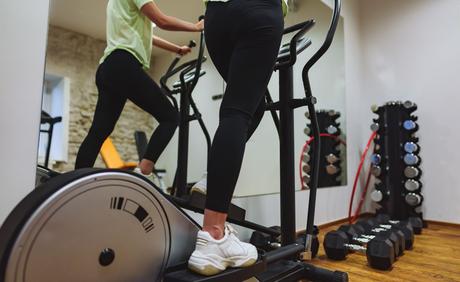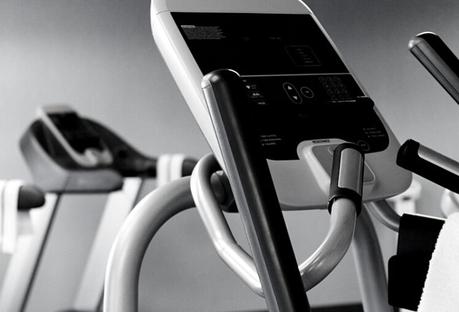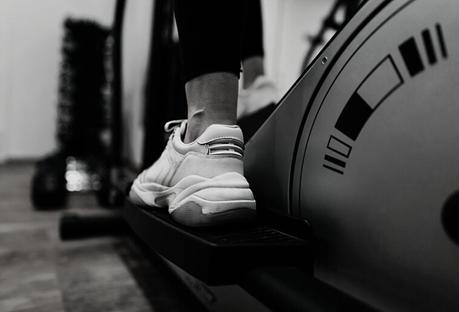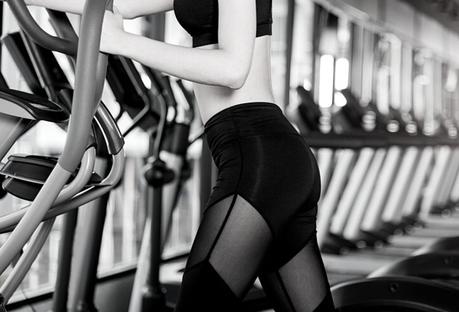The elliptical machine is one of the best cardio machines for beginners. Here are three beginner-friendly elliptical workouts to get you started.
 In This Guide:
In This Guide:- Why Beginners Should Train with an Elliptical
- Beginner Elliptical Workouts
- Beginner Elliptical Workout #1: 20-Minute HIIT Challenge
- Beginner Elliptical Workout #2: 30-Minute Full Body Session
- Beginner Elliptical Workout #3: Glute-Blaster
- Beginner Elliptical Workouts – FAQs
- Is 10 minutes of elliptical enough?
- How long should a beginner workout on an elliptical?
Even if you’ve never used an exercise machine in your life, you’ll find that there are plenty of simple, newbie-friendly workouts you can do on the elliptical.
The elliptical has a small learning curve—it will take you no more than a minute or two to find your stride—and once you’ve mastered that, you’re off to the races.
It doesn’t matter if you’re brand new to the gym or just taking your first steps toward improving cardio, there’s a workout for you.
In fact, below, I’ll share with you three beginner elliptical workouts that literally anyone can do. They’re created to be short (20 to 30 minutes), and though they’ll push your body to its limits, you’ll have no trouble mastering the basics of working out on the elliptical.

Why Beginners Should Train with an Elliptical
Before we dive into the beginner elliptical workouts, I want to take a moment to highlight some of the reasons that the elliptical machine is one of the best cardio machines to incorporate into your workout.
I’ll spare you the complicated technical talk and jargon, but really, at the end of the day it comes down to a few simple advantages that the elliptical offers:
 Works More Muscles
Works More Muscles

No other cardio machine in the gym works as many muscles as the elliptical machine. Seriously.
The treadmill works just your legs. Same for the Stairmaster. The exercise bike and Jacob’s Ladder, too.
The rowing machine gets some more muscles working—your upper back, lower back, biceps, and shoulders—but it’s still not quite a full-body workout.
But when you look at the muscles worked on the elliptical machine, you see quite a different story!
With every stride, your leg muscles—quads, calves, hamstrings, glutes, and hips—work together to keep your lower body moving smoothly and supporting your upper body.
As you pull on the handles, your “pull” muscles—upper back, shoulders, biceps, and forearms—engage. Same goes for your “push” muscles—chest, shoulders, and triceps—when you push on the handles.
Your core—abs, obliques, and lower back—have to work to keep your body stable and balanced with every step, and are engaged by the twisting motion of the elliptical machine.
At the end of the day, one of the greatest benefits of elliptical trainers is that they work all your muscles, meaning more endurance built and (as you’ll see below) more calories burned.
 Burns More Calories
Burns More Calories

You’ll find that losing weight with an elliptical is fractionally easier than losing weight with most of the other cardio machines (excluding the treadmill and rowing machine).
Look at how many calories you burn during a run or rowing session, then compare that to the calories burned on the elliptical machine, and the elliptical usually comes out ahead.
This is because you’re engaging more muscles in your elliptical workout, and the more muscles you engage, the more energy (calories) your body has to burn to sustain the effort.
Over the course of a 30-minute workout, the difference begins to tell, and you’ll see the number of calories expended rising much faster because you’re burning through your existing energy stores much faster and your body is rushing to replace it—typically, by activating stored fats.
This is why elliptical training is better for fat-burning and healthy weight loss than most of the other cardio machines in the gym.

 Easier to Adapt
Easier to Adapt

The more versatile the machine, the more options you have for your workouts.
With the treadmill, you’ve got pretty much three choices: walk, jog, or run. With the stairclimber, you either climb faster or slower. Same with the rowing machine.
The elliptical, however, gives you a lot more options for effective workouts. To name just a few:
- Raise the incline and resistance to hammer your glutes.
- Try going backwards on the elliptical to pay extra attention to the muscles supporting your knees
- Squat-walk to set those quads and glutes on fire
- Reduce leg engagement to force your upper body to work extra-hard
- Squeeze the core with every step to max out your ab and lower back training
It’s a much more versatile machine than most in the gym, making it highly effective for a wide range of training methods.
 Gentler on Your Body
Gentler on Your Body

This is one of my favorite benefits of the elliptical machine, hands-down.
There are a lot of high-impact training methods—running, plyometrics, CrossFit, jump training, sports, and the list goes on.
All of these training methods cause microscopic damage to your bone, joint, and muscle tissue, which forces your body to repair that damage and thereby strengthens your skeletomuscular system.
But doing only high-impact exercise can put quite a strain on your body. Over time, you’ll be more prone to developing injuries, not to mention feeling the aches and pains of your workouts.
That’s why it’s a good idea to mix in low-impact exercise that is gentler on your joints and bones. Your body will have a chance to recover between training sessions, reducing the risk of developing permanent injuries or straining your joints or muscles beyond their ability to repair.
The elliptical machine is one of the lowest-impact workouts of all. There is no lifting your feet from the pedals, and no subsequent placing it down once more to cause impact.
Beginner Elliptical Workouts
Ready to give it a go? Don’t worry: it’s easy to learn how to use the elliptical, and the workouts below are crafted specifically with beginners in mind.
You’ll push yourself hard, but it will never be too difficult for even the newest newbie to get through.
Beginner Elliptical Workout #1: 20-Minute HIIT Challenge
Let’s start off with a fun one: an elliptical trainer HIIT workout.
HIIT, or high-intensity interval training, involves periods of high-intensity effort with low-intensity periods that allow you to rest and recover.
Alternating between the two pushes your muscles and cardiovascular system to the max, but gives you a much-needed time to catch your breath. The result is better muscle-building, increased calorie expenditure, and long-term fat burning from the metabolic boost.
This 20-minute HIIT workout is fairly simple:
Start with a Warm-Up – Spend 5 minutes striding at a fairly normal pace. Aim to get your heart rate in the 50 to 60% range (you’ll see it displayed on the elliptical, or feel yourself beginning to feel warm and sweat lightly). This will get your heart pumping, your blood flowing, and your muscles warmed up.
After 5 minutes, it’s time to work!
Push it to the MAX for 30 seconds. For a full 30 seconds, pedal/stride as fast as you can. Don’t worry about raising the resistance or the incline, just focus on going as fast as possible for the full half-minute.
Slow it down for 90 seconds. As soon as you hit the 30-second mark, slow it down to the same pace as your warm-up. You’ll need the full 90 seconds to regain your breath, and get ready to do it all over again.
Repeat a total of 10 times. Ten repetitions of 30-second high intensity and 90-second low-intensity intervals will be a total of 20 minutes, and you’ll end the workout sweating buckets and feeling like a million bucks!
But it’s not over quite yet.
Cool down. This is critical after pushing your body to the max for the 20-minute HIIT workout. Spend another 5 minutes at a slow pace, allowing your tired muscles to loosen up and cool down, your breathing to return to normal, and your heart to slow down.
It’s a simple workout, but you’ll find it does an amazing job of burning calories and increasing your cardiovascular endurance.

Beginner Elliptical Workout #2: 30-Minute Full Body Session
One of my favorite 30-minute elliptical workouts involves a concentrated workout on every part of your body.
The full-body blaster targets all of your muscles and joints to increase your muscular strength and endurance from head to toe.
Don’t worry if you struggle at first—the more often you train, the easier it will become to master.
Start with a warm-up. Again, spend those 5 minutes beforehand warming up at a gentle pace. You want your muscles to feel limber, loose, and warm before you push them hard. Aim for that 50 to 60% Max Heart Rate zone to get you fat burning and blood flowing.
Minute 0-5: Focus on your upper body. Now that your body is feeling good, it’s ready to work. Try to reduce the amount of effort your legs bring to the table, and engage your arms to really work those handles. Push and pull as hard as you can to keep yourself striding forward. Feel free to increase the resistance to make it more difficult for your arms to pedal.
Minute 6-10: Squeeze your core. Every minute, on the minute, focus on engaging your core muscles and really squeezing them as hard as you can. Aim for 15 seconds at first, working your way up to 20, 25, and 30 seconds. The goal is to tense your core muscles for 30 to 45 seconds out of every minute, with the rest of that minute to relax the muscles and let them recover.
Minute 11-15: Hammer your quads. Try this on for size: grip the elliptical’s stationary handles and walk in a squat for a count of 10 to 15, as many as you can sustain before your legs feel like they’re on fire. Give yourself 60 to 90 seconds to rest, then do it all over again. Fit as many squat-walks into the 5-minute period as possible.
Minute 16-20: Reverse and squeeze your core. Stop striding forward (your natural stride), and reverse directions so you’re striding backward. It will take a few minutes to get used to the change of direction, so pay attention to your form and posture until it’s comfortable. After that, spend the rest of the time squeezing your core and really engaging your abs, obliques, and lower back muscles in the same pattern done during Minute 6-10.
Minute 21-25: Squat walk once more. Your quads are the largest muscle group in your lower body, so they can take a lot of hammering. It’s worth paying them a lot of attention, especially when walking in reverse. The movement will train the lower quads that support your knees, making your knees more resilient and less prone to injuries.
Minute 26-30: Target your glutes. Raise the incline to the max, and add a bit of resistance. Doing so will not only target your glutes (with a bit more focus on your hamstrings, too), but make every step feel like a greater effort. Keep working at a normal speed but with max incline until the 30-minute mark.
Cool down. Finish off your workout at a slow, steady pace, with the incline and resistance set to 0. Your muscles have worked hard, and they deserve a “rest” period to recover before you get on with the rest of your day.
Beginner Elliptical Workout #3: Glute-Blaster
The elliptical is one of the best cardio machines for glutes, because when the incline is set to max and you add a bit of resistance, it works out your glute muscles in a manner very similar to the stairmaster machine.
If you’re all about building glutes on the elliptical, this is the workout for you!
Warm up. No better way to start any workout! Give yourself 5 minutes of no resistance, no incline, and a moderate pace to get your blood flowing.
Here comes the tricky part: every minute on the minute, adjust the resistance and incline as instructed below (using the elliptical’s built-in buttons) to make the workout not only more glute-centric, but also more difficult.
Give it 20 minutes, and get ready to work hard!
Note: The numbers below are based on inclines of 1-10, and resistance levels of 1-10. However, be aware that some machines will have more incline and resistance levels—up to 15 or 20—so adapt the numbers accordingly.
Minute 1: Incline 3, Resistance 2
Minute 2: Incline 4, Resistance 2
Minute 3: Incline 5, Resistance 2
Minute 4-5: Incline 5, Resistance 3
Minute 6: Incline 6, Resistance 3
Minute 7: Incline 7, Resistance 4
Minute 8: Incline 8, Resistance 4
Minute 9-10: Incline 9, Resistance 3
Minute 11: Incline 7, Resistance 5
Minute 12: Incline 8, Resistance 5
Minute 13: Incline 9, Resistance 5
Minute 14-15: Incline 10, Resistance 6
Minute 16: Incline 10, Resistance 6
Minute 17: Incline 10, Resistance 7
Minute 18: Incline 10, Resistance 8
Minute 19-20: Incline 10, Resistance 10
Make sure to spend a few minutes cooling down, and you are DONE!
Beginner Elliptical Workouts – FAQs
Is 10 minutes of elliptical enough?
10 minutes of any exercise per day just isn’t enough to really push your fitness to the max.
Sure, HIIT machines like the treadmill or elliptical allow you to get in a better workout in a shorter amount of time, but typically, that’s within 15 to 25 minutes (plus warm-up and cool-down time).
If you really want results, it’s worth spending more than 10 minutes per day on the elliptical machine.
How long should a beginner workout on an elliptical?
If you’re going for a HIIT workout, shoot for 20 minutes (not including warm-up and cool-down).
If you’re doing a more muscle-building-focused workout, 30 minutes is the sweet spot.
And if you’re keeping it “low and slow” (low-intensity, steady-state training), anywhere from 45 to 60 minutes should be your target.
The Bottom Line
Thanks to these beginner elliptical workouts, you’ve got lots of options to help you start training using this amazing cardio machine.
Put in the time and effort, and you’re all but guaranteed to see results!
More Stuff Like This
The Different Types of Elliptical Machines (Pros and Cons of Each). The elliptical machine is one of the best tools for achieving your weight loss goals. Here’s a look at each type of elliptical machine, including the pros and cons of each, so that you can use the right one for you and your training goals.
How Much Do Ellipticals Cost? (44 Different Models Compared). Ellipticals can be a costly investment in your workout goals. Here is a look at how much each type of elliptical costs and how much to spend on one.
